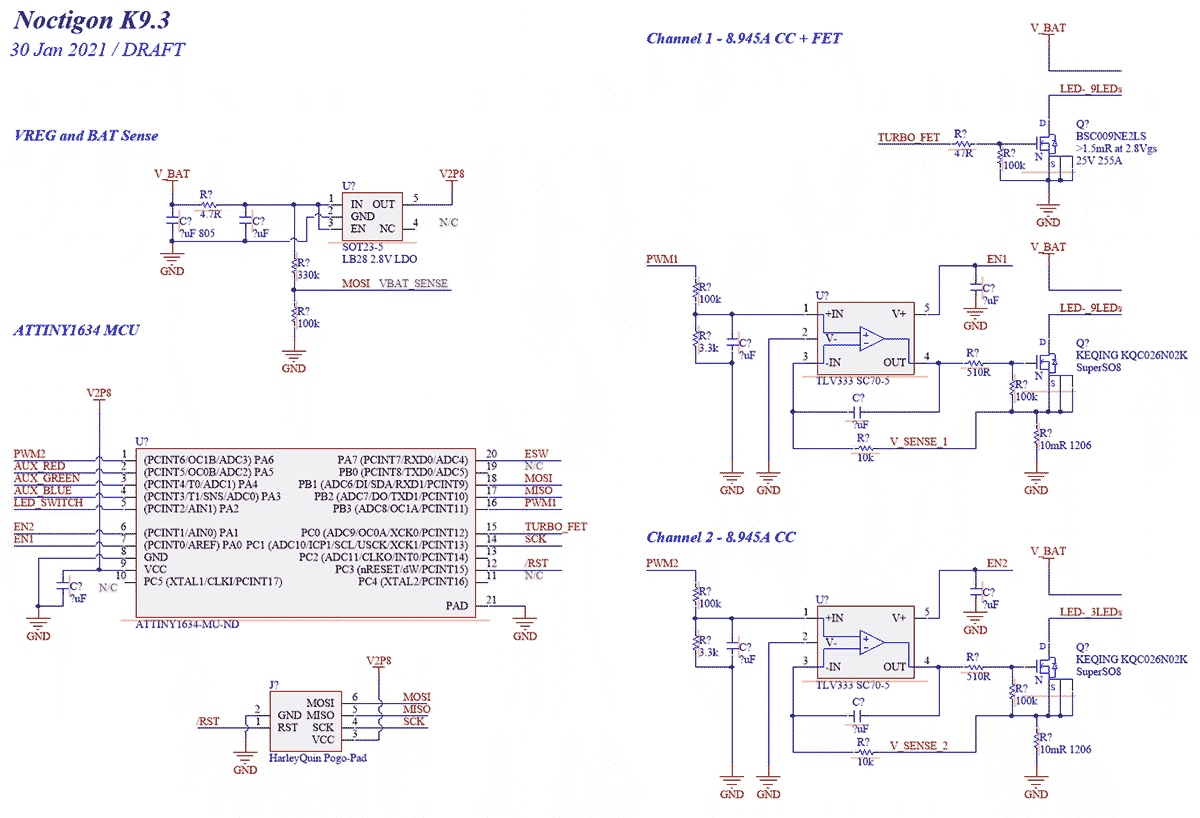Welcome on BLF !
Is being overwelmed the natural state of BLF? ![]()
and thank you… I am excited for a new side project.
Here’s an Emissar 2 channel+FET linear driver schematic :
Courtesy of Loneoceans
1 channel+FET linear drivers are the same, just with one fewer linear channel.
Different current configurations are done with different top voltage divider resistor at PWM pins (100k in schematic above 3.3k), 5A uses 180k and 7.5A 120k
Thanks
Ok, I see what’s happening, 2 channel linear drivers with a turbo driver fet on channel 1. Its interesting that they are using individual channels for the aux leds… Why not Neos with one channel of aux for like low level red? I feel like you could add more functionality with neos. Like it only uses one channel so you can have one channel for the switch and another for the main SO like your switch can be showing you bat info while you are using the main Led for something else. And it could have a ring of 4 lights and the if its at 50% it shows only 2 with like a yellow color.
Is there a reason the community doesn’t use the neos. And goes for the rgbs instead?
What are neos ?
Edit : Ah this : NeoPixel 5050 RGB LED with Integrated Driver Chip - 10 Pack : ID 1655 : $4.50 : Adafruit Industries, Unique & fun DIY electronics and kits ?
Adressable LEDs are cool but usually too large, this is 5050 when RGB LEDs commonly used on AUX and button boards are 1615 and can’t be really larger than that.
In a couple of my mods I even use 0.7x0.7mm RGB LEDs
1515 or the the 2020 are your friend… Let me shine some light on the subject Neos have gotten tiny… I have made some absolutely tiny neopixel switch combo pcbs for lightsabers. So yes, they are small. I think there is a bit of KISS when to comes to flashlights. AKA Keep It Simple Silly. Neos throws in a whole new element in the mix. ANd it forces people to rethink the code. Wiring become simpler and then the code becomes more complex. Which could be a lot for these little atty chips
ok I just saw some 1010 neos… just wow.
Oh I didn’t know they get this small, now that’s interesting, especially with the 1515 size, this would enable regularly requested features like aux brightness control (not just two levels), various color/brightness animations, like you said different front/button aux behavior, it would also fix the color disbalance at low level.
That said the other important point I didn’t mention is the price, for a mod the cost is fine but not for a Chinese flashlight manufacturer puting 4 or 8 of these in a light it’s not (I couldn’t find a listing for 1000 or more though, maybe it’s not too bad with large quantities).
What does @ToyKeeper think about these ?
Edit : power supply range says 3.7-5V so they’re not suitable for single cell Li-ion.
These look to be the same : https://www.digikey.fr/fr/products/detail/inolux/IN-PI15TAT5R5G5B/14555725
0.17$ for 1000, vs <0.05$ for 1615 RGB LEDs.
But anyway it wont work with li-ion.
Maybe there exists a Chinese equivalent, that would work down to 2.7V, but it’s always difficult to find specific stuff from Chinese distributors.
These flashlights are designed to use less than 0.1 mA in standby mode, even while the aux LEDs are illuminated and animated… and they do this all the way down to 2.8V or so, where they could still run but it shuts everything off to avoid over-discharging the battery.
This gives a runtime (per charge) measured in years – while the aux LEDs are on.
If I understand correctly, NeoPixels would require a boost converter to get enough voltage, and would dramatically increase the amount of power required, so standby time would be measured in hours or days instead of years.
Definitely much more than hours(unless the led chip are power hungry, i didn’t check), low power boost converters are very efficient, for example an SP10s/pro in standby doesn’t kill the cell in hours, it draws less than 50uA on NimH IIRC, less on li-ion, but yes it’s a bit too convoluted to have to use a boost converter.
Lightsabers are fun, no?
I built a lightsaber for myself a while back, starting with the circuit board. I used a 25mm circle which fits just under the LED pill, and a couple wires leading back to the battery chamber. Since the battery has a lot of extra room and I wanted to balance the hilt better, I wrapped the battery in sheets of lead.
The circuit board has 4 independent channels, each at around 1A of power, for red / yellow / green/ blue LEDs. These are PWM’d at 16 kHz to adjust brightness.
Then of course, I made firmware for it. The interface is pretty simple, with just on/off, battery check, lockout, and factory reset. But while it’s on, the user can select from a dozen different color patterns that they created themself.
Each color pattern is configured in a manner similar to turning knobs on a 2-oscillator synthesizer. Select your waveforms and frequencies, oscillating between 2 points in a 2D color space – hue on one axis, and value+saturation on the other axis. Plus an optional 2nd oscillator to adjust the output in more complex ways, and an “overdrive” button to flash the blade brighter during use.
Much like flashlights, there is no need to disconnect power when it’s not in use. The standby time is like 5 years or longer.
I really should update the firmware sometime. The last version only updated the LED colors at around 62 Hz, which is pretty visible while swinging it around. So I was going to go back and increase it to at least 250 Hz if not higher. But I broke my test board, and never got around to building a new one, and the project stalled.
I checked before posting. Only a quick search, but still. The numbers I found were like 1 mA per LED while the LEDs are off, or up to 60 mA per LED while they’re on.
For an Emisar D4v2, which uses 8 RGB aux LEDs, that works out to a standby time of anywhere from 6 hours to 15 days. As far as I can tell, it wouldn’t be practical to leave the aux LEDs on during standby mode… which would be unfortunate, since that is their primary purpose.
But maybe there are low-power neopixels which didn’t turn up in my quick search.
Ok yeah so the chip is power hungry, definitely not adequate for our application.
Oh ya that makes sense… Well you could throw in another small fett if you wanted to use neos with accent led color. Neos do tend to want power with 30ma on average. But I was looking at the rgb and some of them use 100ma.
@thefreeman Neos are used on lightsabers all the way down to 2.5v, If I remember correctly. So if you can run IC you can run neos. basically they will use a bit more power and require another mosfet.
Anyways its a different use case… But I am sure there is a place for neos. With the addition of a mosfet… I wouldn’t totally count them out.
In off… lightsabers can depending on the board can last for months to years with out a charge. I believe neos shut down at 2.7v. And I run neos off of the 3.3v with out any issues all the time. It true they play best with 3.5v to 5v but its not necessary. I have a blaster that has about 30 neos in it and that board doesnt use a booster. Sound isnt as loud but neos work the same.
Anyways… as I said I think there is a place for neopixels. especially working in tandem with other accent leds. As I said before its the coding thats a pain.
Question what do you use for temp sensing I noticed that the audriul had the temp sensing?
It’s built in to the attiny chips. The built-in sensor is the primary method it uses to measure temperature.
I tried searching for RGB LED drivers that wouldn’t be integrated into each LEDs, hopefully meaning lower power consumption, found that one : KTD2026 3-Channel RGB LED Driver with I2C Control | Kinetic Technologies
2.7-5.5V, 24 mA 3 channels, I2c,<1uA in shutdown, 200uA with LEDs OFF, 300uA with 3 channels ON, quite better than 1mA per LED. DFN 1.5x1.5mm so it’s small enough to place on an AUX PCB, 125uA per step (192 steps) might be a bit too coarse though. Pretty cheap at 50c/pcs for 10.
The KTD2026/7 are fully programmable, constant current RGB or RGBW LED drivers with a flexible control interface. The devices are ideally powered from one-cell lithiumion/polymer, 3-cell NiCd/NiMH/Alkaline batteries, or systems with 3.3V or 5V supplies. The independent programmable constant current sinks operate without external components.
With an on-chip timing control unit, LED blink rate, fade-in and fade-out are user-adjustable resulting in unique color lighting patterns.
Ten internal registers are programmed via the I2C interface with a built-in decoder allowing individual control of the three/four LED channels’ On/Off state and current level. A total of 192 current levels are available for each channel from 0.125mA to 24mA with a 0.125mA step.
Well the whole point of the neo is to be integrated. and if you control power with a mosfet so the drain is totally minimized. So if they flash just write the mosfet pin high then off again when its done. when in use they dont use much more than the rgbs do… would use this on flash light that I charge the battery regularly. like slapping them into a bike light. Another point is that if you arent using all of the rgb its more drain than the 1 to 2 of the neos. Was that something that was considered? anywayss… I got my question anyways I got my understand why you use RGB over neos.



